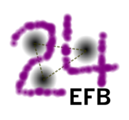Speaker
Description
We calculated bound states of quark-antiquark systems in which at least one of the constituents is a charm or bottom quark. We use a Minkowski-space formalism known as the Covariant Spectator Theory (CST), which, for example, has been successfully applied in exact relativistic calculations of two- and three-nucleon systems based on one-boson-exchange dynamics. It is also used quite extensively in phenomenological quark-diquark descriptions of baryons. The basic idea of the CST is to approximate the integration over the energy-component of the loop four-momentum in the Bethe-Salpeter equation by neglecting residues of poles in the kernel and keeping only those of the constituent particle propagators. This approximation can be shown to converge to the solution of the Bethe-Salpeter equation with the complete kernel (with all ladder and crossed-ladder diagrams) when one of the two particles becomes infinitely heavy. It should therefore be particularly well suited for the case of heavy and heavy-light mesons.
We use a covariant interaction kernel that consists of a Lorentz vector one-gluon exchange and a covariant generalization of a linear confining interaction with a mixed Lorentz structure, containing an equal-weight scalar+pseudoscalar term, and a vector term, whose relative weights can be changed through an adjustable parameter. In principle, scalar and pseudoscalar interactions break chiral symmetry, but in our formalism it is possible to include such interactions and still satisfy the constraints of chiral symmetry.
By fitting various sets of experimental masses of the heavy and heavy-light meson spectrum, we found that very good agreement can be achieved by adjusting a small number of global model parameters. It turned out that the relative weight of scalar+pseudoscalar versus vector confinement is not much constrained by the mass spectrum. In addition to the masses, we also calculated the corresponding relativistic wave functions, which are then used to calculate meson decay constants, some of which have been measured with high precision. We also investigated how much our results change when a fixed strong coupling constant $\alpha_s$ is replaced by a running coupling $\alpha_s(Q^2)$, and how much they depend on details of our regularization scheme.

